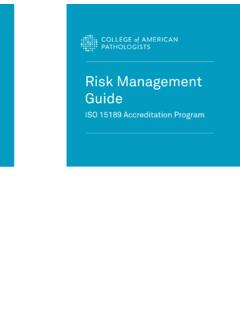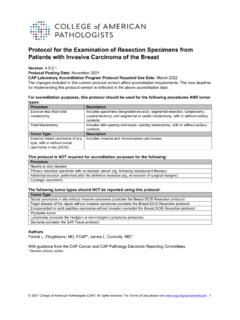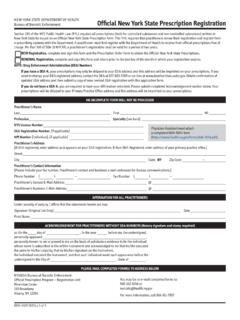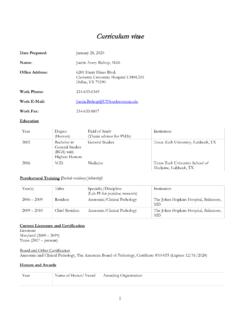Transcription of Overview of Anatomic and Clinical Pathology
1 College of American of Anatomic and Clinical PathologyValerie A. Lockhart, MD, MBA, FCAP College of American August 20192 The key take awaysof this deck:1. General understanding of Anatomic Pathology2. General understanding of Clinical Pathology3. General understanding of how broad Pathology is4. Insight as to what a resident may do as part of an Anatomic or Clinical Pathology rotation College of American Pathologists. College of American and Clinical Pathology Overview16 August 20193 College of American Pathology is a specialty that offers a great deal of variety and contains two main divisions: Anatomic Pathology and Clinical Pathology . If you choose Pathology for a career, there are three main options for residency training: oCombined Anatomic and Clinical Pathology (4 years)oAnatomic Pathology only (3 years)oClinical Pathology only (3 years) Regardless of the track chosen, Pathology residents are exposed to a wide range of topics and diagnostic methods and graduate with the ability to impact nearly every patient in the healthcare August 2019 College of American Pathologists.
2 College of American Pathology16 August 20195 College of American Pathology -DefinitionAnatomic Pathology primarily consists of tissue evaluation from individual cells from a Pap smear, a fine needle aspiration of a mass, or evaluation of the entire body in an autopsy, and everything in between. 16 August 20196 College of American Pathology SurgicaloPrimary components include gross dissection and histologic evaluation of specimens, as well as preparation and interpretation of frozen sections. CytopathologyoThe study of diseases on a cellular level. ForensicoPerform autopsies to determine cause of death. 716 August 2019 College of American Pathology Like many other residencies, a day in the life includes service work, didactics, and call (which primarily consists of frozen sections).
3 Histologic diagnosis is the foundation of Anatomic August 2019 College of American Pathology There are numerous ways a surgical Pathology rotation can be structured; the primary components include: oGross dissection and histologic evaluation of specimensoPreparation and interpretation of frozen sections Most residency programs have regular conferences scheduled, where residents and attendings come together and view cases, allowing for group discussion, teaching, and intradepartmental August 2019 College of American Pathology -Grossing Gross dissection, or grossing of specimens, is the process by which specimens are prepared for processing. Specimens are rendered into slides, from which a histologic diagnosis can be made. Pathologists assistants play an important role in teaching residents proper grossing techniques.
4 16 August 201910 College of American Pathology -Histologic Evaluation In real-world practice after residency, this is the major duty of an Anatomic pathologist. Some practices employ specialists who only focus on a small number of organ systems, while others employ generalists who are expected to render diagnoses on tissue from anywhere. 16 August 201911 College of American Pathology -Histologic Evaluation In residency:oThe goal is to look at as many slides as possible, to learn patterns and diagnostic features that will allow you to make accurate diagnoses as a practicing pathologist. On a given day, you might diagnose: oProstate cancer in an elderly manoA colon polyp in a middle-age womanoEnsure that a child s removed tonsils do not show any significant abnormality16 August 201912 College of American Pathology -Frozen Sections Requested by clinicians where having specific pathologic information helps determine the scope of a procedure.
5 You need to act fast as expected diagnosis is about 20 minutes after receipt of tissue. During a frozen section, you may:oAccess margins of a squamous cell carcinoma on the faceoConfirm the neurosurgeon collected neoplastic tissue from an edematous tumoroDetermine the depth of invasion for a uterine cancer which dictates if a surgeon removes lymph nodes for staging16 August 201913 College of American Cytopathology is the study of diseases on a cellular level Includes examination of cells in:oPap smearsoFine-needle aspirations of massesoFluids such as pleural fluid or ascitic fluid from the abdomen Relies on subtle cellular features to distinguish malignant from benign, classify cells based on origin, and ultimately direct further action (or inaction) for the August 201914 College of American Cytopathogistsoften perform fine needle aspirations (FNAs) by palpation or using ultrasound to collect diagnostic tissue of suspicious lesions or masses.
6 Cytopathology is unique as it allows pathologists and residents to interact directly with patients and perform procedures. oCytopathology is increasingly being used as it allows for the least minimal acquisition of tissue and provides valuable tissue that can be used for molecular August 201915 College of American Real-time services to clinicians who are collecting samples for cytology determine whether a sample is adequate for cytologic evaluation or not. On a given day, you may diagnose: oA woman s breast carcinomaoA malignant lung tumoroA benign salivary gland mass16 August 201916 College of American Pathology Autopsy pathologists evaluate corpses to determine why they died. Work closely with law enforcement to determine manner and cause of death. Required to appear in court from time to time to explain autopsy findings.
7 Includes hospital autopsies to determine why patients died in the hospital. Residents are required to participate/conduct a specified number of autopsies by the end of August 201917 College of American Pathologists. College of American Pathology16 August 201918 College of American PathologyClinical Pathology covers most of laboratory medicine including routine tests such as glucose and sodium, up to molecular tests for cancer markers and genome August 201919 College of American Pathology Involves spending time in the laboratory learning about how lab tests are run. Includes numerous areas, such as blood bank, microbiology, hematology, chemistry, and molecular. Quality control, proficiency testing, and laboratory management are also important August 201920 College of American Pathology Understanding specimen requirements, testing methodology, and interpretation of results is key!
8 May answer questions from ordering physicians regarding the appropriateness of a test or how to handle samples for certain August 201921 College of American Bank/Transfusion Medicine Test for blood type and antibodies in order to determine what blood products may be suitable for a given patient in need. Identify antibodies in blood, determining the cause of a patients transfusion reactions, and assisting in the determination of appropriate blood products to be transfused. Includes apheresis procedures and therapeutic phlebotomy, which are generally performed by laboratory/nursing staff and supervised by August 2019 College of American Bank/Transfusion Medicine Rotation May include stem cell collection and transplant, HLA typing and matching, and blood donation services. Transfusion medicine pathologists will often see patients including performing physical examinations and taking histories.
9 You may learn: oHow to perform a type and screen and transfusion reaction workupoTalk to clinicians about what blood products are indicated for their patientsoPerform a plasmapheresis procedure on a patient with Thrombotic Thrombocytopenic Purpura (TTP)2316 August 2019 College of American Diagnosing bacterial, viral, and fungal infections using various laboratory testing methods. Residents will get hands-on experience with:o Plating specimensoPerforming biochemical testingoSetting up tests for definitive organism identification and susceptibility testing2416 August 2019 College of American Learn to identify organisms based on a variety of characteristics and tests. Molecular testing is increasingly used in microbiology to identify organisms and aid in detecting antibiotic resistance.
10 Pathologists specializing in microbiology are frequently consulted and work closely with hospital infectious disease doctors and epidemiologists. 2516 August 2019 College of American Pathology Classify disease based on macromolecules, such as RNA and DNA. Learn the steps required to access molecular data, exponentially increase the amount of data, and measure the intended target(s) from a given sample. Learn how laboratory tests can be used to determine the presence or absence of common genetic mutations in tumors, diagnose certain infectious diseases, such as herpes simplex virus or human. papillomavirus, or evaluate segments of human DNA (or possibly the whole exome) for variants that may contribute to August 2019 College of American Pathology Residents will learn: oWhat specimens can be used for molecular testingoDifferent indications for molecular testingoHow to set up specimens for testingoHow to perform quality controloHow to interpret results2716 August 2019 College of American Unique Pathology subspecialty that involves both Anatomic and Clinical pathologyoPerform and interpret bone marrow biopsiesoLymph node analysisoExpertise in the hematology, flow cytometry, and coagulation sections of the laboratory You might start your day in the lab, learning how to do a differential on a CBC, set up specimens for flow cytometry analysis.















